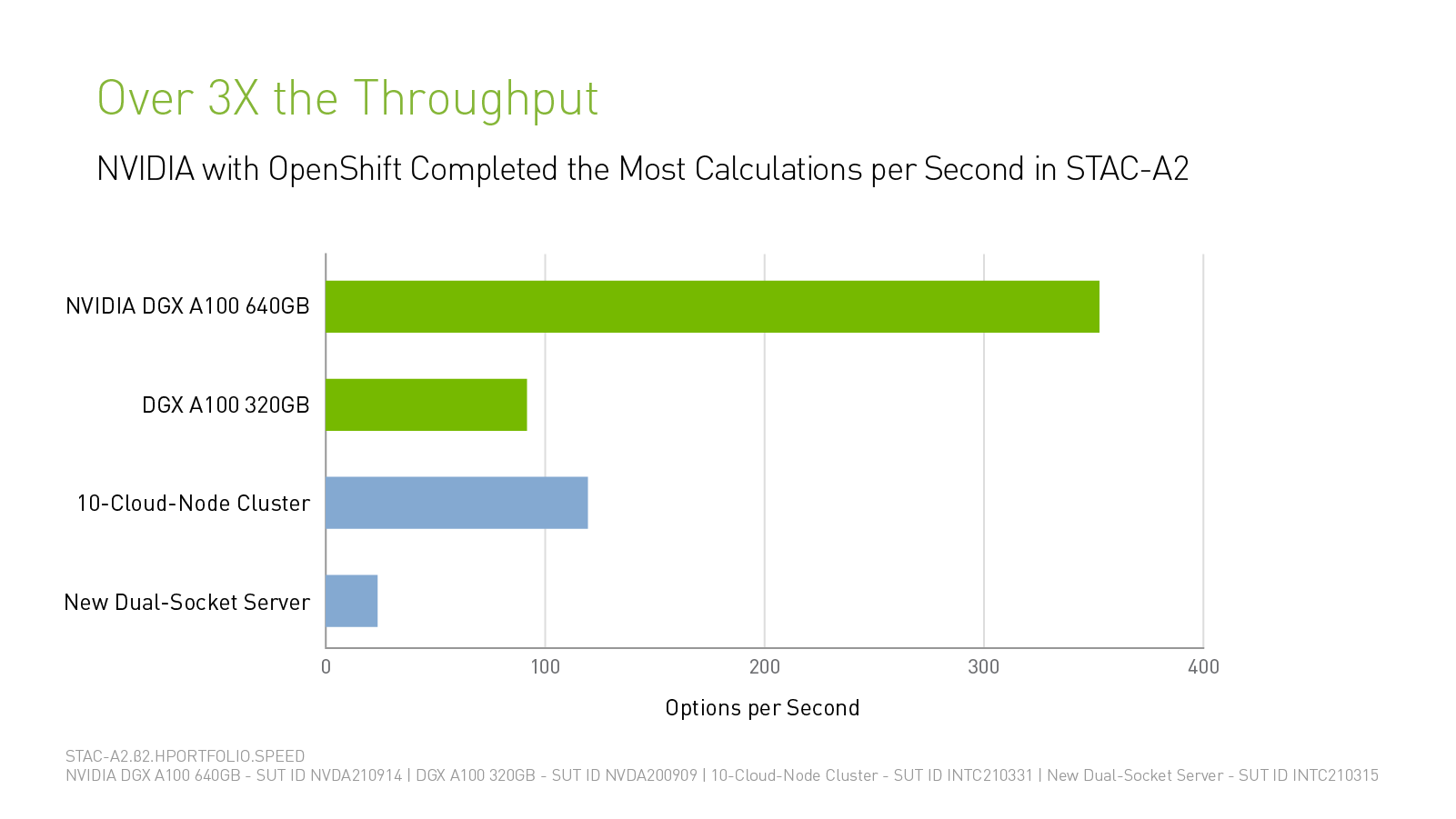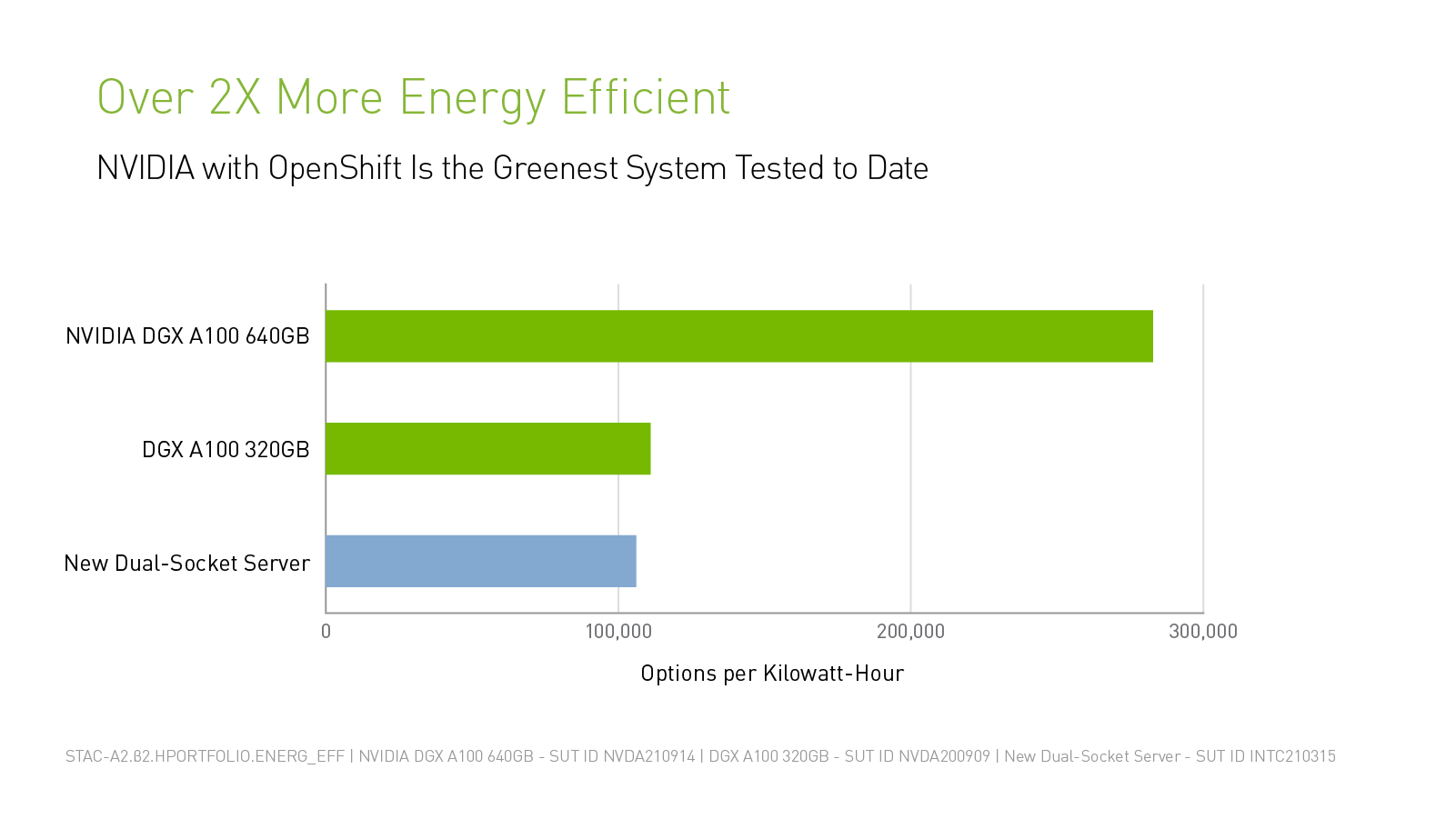Amid increasing market volatility, financial risk managers are looking for faster, better market analytics. Today that’s served up by advanced risk algorithms running on the fastest parallel computing systems.
Boosting the state of the art for risk platforms, NVIDIA DGX A100 systems running Red Hat software can offer financial services firms performance and operational gains. These systems used a fraction of the energy and space of rival servers in recent benchmark tests.
The latest NVIDIA DGX systems, with 640GB of GPU memory each, landed eight performance records on the financial industry’s widely watched STAC-A2 benchmark of financial risk models, including taking top honors for energy and space efficiency.
Some of the largest firms on Wall Street and the broader global financial industry rely on the STAC-A2 as a key risk model benchmark to measure compute platform performance.
These were also the first publicly released STAC-A2 results for a solution using containers that have been audited. Kubernetes, an open source container orchestration platform, has become the de facto standard for managing containerized workloads, which are instrumental in deploying complex multi-stage workflows. Red Hat OpenShift software is the industry’s leading enterprise Kubernetes platform.
The STAC-A2 results highlight the flexibility of DGX A100 systems for integrating with the latest deployment models and Red Hat as a provider of a Kubernetes environment that can meet the most demanding enterprise performance requirements.
Nearly 15x More Throughput
The latest NVIDIA DGX A100 systems with 640GB of GPU memory deliver 14.8x greater throughput (number of options priced per second)1 than a recently tested solution based on a single, standard CPU server — a dual-socket CPU-based system2 — as measured by the STAC-A2 benchmark. It also outperforms previously tested systems based on 10 CPU-only cloud nodes3 and 8x dual-socket CPU-based servers4.

The record results from NVIDIA have been audited by the Securities Technology Analysis Center (STAC). Members of the STAC Benchmark Council include over 450 of the world’s leading banks, hedge funds and financial services technology companies, which contribute to the benchmark’s makeup. The STAC Report is available here.
Efficiency for Reduced Operating Expenses
Big banks, hedge funds and risk managers across financial institutions stand to benefit from not only data throughput advances but also improved operational efficiencies.
Reduced energy and square footage expenses for systems in data centers can make a big difference in operating expenses. That’s especially important as IT organizations make the case for budgetary outlays to cover new systems.
The latest DGX A100 system with 640GB of GPU memory5 offers lower operating expenses:
- 2.6x the energy efficiency6
- 2x the space efficiency of a CPU-based cluster system tested in 2018 and 4x the space efficiency of a recently tested CPU-based system7.

Understanding STAC-A2: Meet the Greeks
The STAC-A2 market risk benchmark simulates fluctuations in interest rates and other security price factors over time, evaluating their impacts on options prices. One important step is the simulation of underlying security prices paths, which is depicted in figure 1. The STAC benchmark involves computing the evolution of thousands, if not hundreds of thousands, of these security price paths grouped by security.
These simulated results are used in sensitivity calculations that make up risk scores known in the finance industry as “the Greeks.”
STAC-A2 simulates these option-price sensitivities (the Greeks) for multiple assets by applying a financial analytics technique called Longstaff-Schwartz Monte Carlo.
Using a Monte Carlo simulation (randomly sampling a probability distribution much like in figure 1) with the Longstaff-Schwartz method (a backward iteration algorithm, which steps back in time from a maturity date) solves for option-price steps over time.
The technique enables financial services firms to calculate the risk of current holdings in the future and of potential trades.
DGX Devours STAC-A2
- DGX A100 with 640GB of GPU memory8 didn’t just move the bar a little bit. Compared with the best previous numbers from non-NVIDIA accelerated systems, it opened a wide gap: 3x the throughput9, and 2.6x the speed in the warm baseline Greeks benchmark10
NVIDIA set new time-to-solution records for the large problem size as well — 2.3x the speed in the warm large Greeks benchmark compared with the fastest non-NVIDIA system (an eight-node CPU-based cluster)11.
DGX systems have always been about performance at scale, so it’s no surprise that it set new records for the maximum number of assets and paths that can be simulated12. The latest DGX systems can handle more than 2x the assets of the best non-NVIDIA system tested13 (despite the fact that the workload increases quadratically with the number of assets), and 20x more paths than a recently tested CPU-based server14.
NVIDIA DGX was designed to address the world’s most challenging compute problems efficiently and at scale. These latest STAC-A2 results show its strength in delivering on that vision.
Learn more about NVIDIA DGX systems.
1 STAC-A2.β2.HPORTFOLIO.SPEED
2 SUT ID 210315
3 SUT ID INTC210331
4 SUT ID INTC181012
5 SUT ID NVDA210914
6 STAC-A2.β2.HPORTFOLIO.ENERGY_EFF vs. the Ice Lake based server SUT ID INTC210315
7 STAC-A2.β2.HPORTFOLIO.SPACE_EFF vs. SkyLake cluster SUT ID INTC181012, Ice Lake SUT ID INTC210315
8 SUT ID NVDA210914
9 STAC-A2.β2.HPORTFOLIO.SPEED vs. the 10 node cloud cluster SUT ID INTC210331
10 STAC-A2.β2.GREEKS.WARM vs. an 8x NEC Vector Engine SUT ID NEC210422
11 STAC-A2.β2.GREEKS.10-100k-1260.TIME.WARM vs.Skylake cluster SUT ID INTC181012
12 STAC-A2.β2.GREEKS.MAX_PATHS and STAC-A2.β2.GREEKS.MAX_ASSETS
13 STAC-A2.β2.GREEKS.MAX_ASSETS vs. the 8 way Skylake cluster SUT ID INTC181012
14 STAC-A2.β2.GREEKS.MAX_PATHS vs. the Ice Lake based server SUT ID INTC210315
